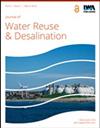基于响应面法的再生造纸废水高速厌氧消化过程参数相互作用的建模与优化
IF 2.3
Q2 Environmental Science
引用次数: 3
摘要
本研究采用新型厌氧折流板反应器对再生造纸废水(RPMW)进行了厌氧消化。对进水化学需氧量(CODin)和水力停留时间(HRT)之间的参数相互作用进行了建模,并采用响应面法(RSM)采用三级因子设计对工艺响应进行了优化。结果表明,在CODin为4000mg/L、HRT为2天的条件下,COD去除率、生物需氧量(BOD)去除率、木质素去除率、CH4含量和CH4产量的预测值分别为94%、98%、68%、85%和20.8L CH4/d。根据RSM的统计分析,所有模型都是显著的,概率值很低(从0.0045到<0.0001)。参数交互作用表明,增加CODin对COD、BOD和木质素去除效率、出水碱度、甲烷含量和产量有积极影响,但对pH和出水挥发性脂肪酸(VFA)不利。缩短HRT会对COD、BOD和木质素的去除效率、pH值、碱度、甲烷含量和产量产生负面影响,并增加VFA出水浓度。在4000mg/L的COD和2天的HRT下建立了最佳条件,相应于预测的COD、BOD和木质素去除率分别为91%、98%和71%,而VFA和CH4/g COD去除率分别达到28mg/L和0.125L。本文章由计算机程序翻译,如有差异,请以英文原文为准。
Modeling and optimization of process parametric interaction during high-rate anaerobic digestion of recycled paper mill wastewater using the response surface methodology
This study carried out the anaerobic digestion of recycled paper mill wastewater (RPMW) in a high-rate novel anaerobic baffled reactor. The parametric interaction between influent chemical oxygen demand (CODin) and hydraulic retention time (HRT) was modeled, and process responses were optimized by the response surface methodology (RSM) using a three-level factorial design. The results showed that the optimal condition was determined at CODin of 4,000 mg/L and HRT of 2 days and predicted values for COD removal, biological oxygen demand (BOD) removal, lignin removal, CH4 content, and CH4 production were found to be 94%, 98%, 68%, 85%, and 20.8 L CH4/d, respectively. According to the statistical analysis of the RSM, all models were significant with very low probability values (from 0.0045 to <0.0001). The parametric interaction showed that increasing the CODin positively influenced the COD, BOD, and lignin removal efficiencies, effluent alkalinity, and methane content and production but was unfavorable for pH and effluent volatile fatty acid (VFA). Shorting the HRT negatively affected the COD, BOD, and lignin removal efficiencies, pH level, alkalinity, and methane content and production, and increased the VFA effluent concentration. The optimal conditions were established at 4,000 mg/L COD and HRT of 2 days, corresponding to the predicted COD, BOD, and lignin removal efficiencies of 91, 98, and 71%, respectively, whereas 28 mg/L of VFA and 0.125 L of CH4/g CODremoved were generated.
求助全文
通过发布文献求助,成功后即可免费获取论文全文。
去求助
来源期刊

Journal of Water Reuse and Desalination
ENGINEERING, ENVIRONMENTAL-WATER RESOURCES
CiteScore
4.30
自引率
0.00%
发文量
23
审稿时长
16 weeks
期刊介绍:
Journal of Water Reuse and Desalination publishes refereed review articles, theoretical and experimental research papers, new findings and issues of unplanned and planned reuse. The journal welcomes contributions from developing and developed countries.
 求助内容:
求助内容: 应助结果提醒方式:
应助结果提醒方式:


